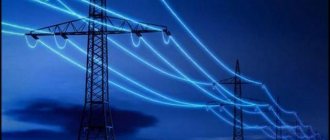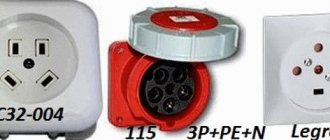What does ODN mean for electricity?
Electricity costs for general house needs (GDE) consist of several factors. This includes lighting of the local area, staircase landings, maintenance of elevator facilities, etc. All this adds up to considerable costs for MKD.
What are the standards for electricity consumption at the ODN used for settlements with the energy supply company? The fair redistribution of electricity costs between apartment owners depends on how the charging system is structured.
Previously, management companies (MCs) of apartment buildings paid for ODN with funds accumulated by subtracting amounts from utility payments of homeowners. It was practically impossible to control the correctness of the accrual of one-time income tax to each owner. Unscrupulous administrators of the management organization took advantage of this, committing fraud with funds.
Starting in 2022, new ODN standards for electricity were introduced. They were determined by calculation, which is closest to the actual electricity consumption for general household needs.
The articles of the new Federal Law (Federal Law) remove from circulation fraudulent schemes that were used to unjustifiably increase the costs of one-way electricity supply, in contrast to the real ones. Cash withdrawals were made from payments made by residents not only in the city, but also in large populated areas throughout the Russian Federation. Innovations forced management administrations to take into account strict rules for accounting, monitoring and saving electricity.
Exceeding standards
In the event that the volumes of electricity supply exceed the established standards, the difference is paid by the utility service provider , represented by the management company, homeowners association or other organization to which the owners have delegated the rights to manage the apartment buildings.
Previously, any expenses, including those exceeding standards, were paid by the owners of residential premises.
In the case where a resource supplying organization is appointed as the provider of public services, the payment of one-time electricity supply in excess of the standards is paid by the owners of residential premises based on the above formulas.
What is included in the ODN
What is commercial electricity metering
The structure of ODN includes all electricity costs, except for residential consumption:
- electric lighting of stairs, platforms, access vestibules and common corridors;
- light in basements and attics;
- power supply for elevator facilities;
- connection and operation of video cameras and intercoms;
- maintenance of fire alarms, pumps and other electrical equipment for public use;
- losses in household networks.
Network losses
Electricity losses in networks are considered to be the difference between the incoming volume of electric current and its recorded consumption inside the house. Losses are borne by additional payment to the electricity distribution company. Reasons causing intra-house current leakage:
- Incorrect selection of wire cross-sections causes thermal losses of electricity in the electrical wiring conductors.
- Poorly assembled contact groups of switches, lamp sockets, switches, sockets, etc.
- Operation of old electrical equipment.
Losses in networks can be reduced only by replacing old electrical wiring with new wires, the cross-section of which corresponds to the load, as well as by replacing worn-out electrical equipment with more modern devices.
Taking readings from the electric meter
Installation, replacement and verification of electricity meters: what has changed since July 1?
Privately practicing lawyer, expert in legal support for the activities of housing and communal services organizations.
From July 1, 2022, for the purpose of metering electrical energy, meters with the possibility of remote transmission of readings must be installed. In legislation, such devices are referred to as an intelligent electrical energy metering system (hereinafter referred to as the ISMS). Corresponding changes were made to the Basic Provisions for the functioning of retail electricity markets, approved by Decree of the Government of the Russian Federation of May 4, 2012 No. 442 (hereinafter referred to as the Basic Provisions), as well as to the Rules for the provision of utility services to owners and users of premises in apartment buildings and residential buildings, approved by Government Decree No. 354 of May 6, 2011 (hereinafter referred to as Rules No. 354),
The responsibility for installing such meters lies with the guaranteeing electricity suppliers, and for consumers.
Meters connected to an intelligent metering system can:
automatically transmit information about readings via wired and (or) wireless communication networks, as well as via power lines using appropriate technologies;
limit and (or) suspend the supply of electricity without the participation of network organization employees in the process;
notify the network organization about the facts of the opening of the electronic seals on the body and terminal cover of the metering device, exposure to the magnetic field of the meter, inoperability of the metering device due to a hardware or software failure, its shutdown (after turning it on again), reboot.
Meters installed before July 1, 2022 are subject to replacement with ISMS if (clause 136 of the Basic Provisions):
- failure of the meter;
- expiration of the meter's service life;
- after the verification interval has expired.
At the same time, both individual metering devices and common house ones are subject to replacement.
In new buildings - apartment buildings that will be put into operation from January 1, 2022, the developer is obliged to install ISMS (communal and individual) and transfer them to the guaranteeing supplier for operation (clause 150 of the Basic Provisions).
How much will it cost to install new electricity meters?
The transition to modern meters (hereinafter referred to as MIS) for consumers will be formally free, since the costs of network organizations, which are obliged to bear the costs of purchasing, installing and maintaining (verifying) MIS, will subsequently be included in electricity tariffs, sales surcharges and payments for technological accession (subclause 12 clause 136 of the Basic Provisions).
Thus, owners will not directly pay for new meters, but will pay all costs as part of electricity tariffs.
There will be a fee for replacing meters from July 1 if the consumer, in the absence of the above grounds for replacing the meter, decides to install a new generation meter.
Timing and reasons for installing new meters
Network organizations are required to install an EMIS within 6 months from the date:
- receiving a request from the consumer about the expiration of the interval between verifications, the service life, as well as about the loss, failure of the metering device and (or) its malfunction;
- identifying the expiration of the interval between verifications, service life, malfunction of the electrical energy metering device, identified during inspections of the management company, homeowners association or RSO. Such provisions are established in paragraph 80(2) of Regulation No. 354.
If the consumer himself has not submitted the appropriate application, the form and mandatory details of which have not yet been approved, to the guaranteeing supplier (most often this is a city power grid, in Moscow, for example, this is Mosenergosbyt JSC), then there will be no liability for this (except for concealing the fact that the meter has failed). At the same time, the exact deadlines for filing such appeals have also not been established. In essence, this is an initiative of the owners who know that the calibration interval of the meters will expire in the near future, and the owner notifies the guaranteeing supplier about this in advance.
If the consumer has not submitted an appeal, then all information about the installed electricity meters (including expiration dates for calibration intervals) and, accordingly, the reasons for replacing meters, the guaranteeing supplier can receive upon request the entire comprehensive organization from the management company, homeowners' association and other organizations that manage apartment buildings (Clause 18.2. Rules mandatory when a management organization or a homeowners’ association or a housing cooperative or other specialized consumer cooperative concludes contracts with resource supply organizations approved by Decree of the Government of the Russian Federation of February 14, 2012 No. 124)
Payment for one day
Electricity consumption standards per person without a meter
In addition to making payments for consumed electricity according to the readings of individual electricity meters, residents of apartment buildings bear the cost of electricity consumption. A special line ODN is included in receipt books for utility services for homeowners.
Payment for consumed electricity according to ODN for one apartment in a multi-storey building is determined by the formula:
Pi=Viodn NS,
Where:
- Viodn – the share of ODNE per apartment.
- N – standard (kWh/1m2), approved by local authorities;
- S – total area of the apartment.
Over the past few years, homeowners of some apartment buildings have begun to notice an unreasonable increase in the amount of payments for electricity bills. This is due to the fact that between the direct consumer and the supplier of electric current there is an intermediary - the management company (MC) of the MKD.
Explanations from the Ministry of Construction.
The Ministry in Letter No. 12368-ACh/04 dated 04/11/2017 explained: when calculating utility consumption standards for electricity supply for the purpose of maintaining common property in apartment buildings, formula 34 takes into account the total area of the premises included in the common property, defined as the total area of the premises, specified in clauses 1, 2, part 1, art. 36 Housing Code of the Russian Federation, including the area of attics and basements.
By virtue of the designated norms of the Housing Code, the owners of premises in an apartment building own by right of common shared ownership the following common property in the house:
- premises that are not parts of apartments and are intended to serve more than one room of the house, including inter-apartment landings, stairs, elevators, elevator and other shafts, corridors, technical floors, attics, basements in which there are utilities, other equipment serving more than one room of the house (technical basements);
- other premises that do not belong to individual owners and are intended to satisfy the social and everyday needs of the owners of premises in the house, including premises intended for organizing their leisure time, cultural development, children's creativity, physical education and sports and other similar events.
Sources
- https://JuristPomog.com/administrative/utilities/nuzhno-li-platit-odn-za-elektroenergiyu.html
- https://estatelegal.ru/zhkx/raschyot-odn-za-elektroenergiyu-v-mnogokvartirnom-dome/
- https://PravaPot.ru/usluga/oplata/raschet-odn-po-elektroenergii-po-normativu.html
- https://PravoNedv.ru/kvartira/zhkh/odn-za-elektroenergiyu.html
- https://www.audit-it.ru/articles/account/otrasl/a831688/999505.html
Standards for ODN for electricity in the regions of the Russian Federation
Introduction to peak and other electricity tariff zones
The size of the standard depends on the quality of the electrical equipment of the house and its number of floors. Standards in each region of Russia are set by local authorities. They represent a single value per 1 m2 of area, relating to communal premises and local areas.
The new rules for calculating ODNE practically exclude unauthorized increases in the amount of payment for this expense item. Previously, the management company itself made payments to the energy supply company, but now the costs of ODNE are borne by the apartment owners according to a special line in the receipt. The calculation of this expense item is based on the standard adopted by the regional state administration.
There is no uniform standard for ODNE for MKD across the country. In different territorial entities of the Russian Federation, indicators vary greatly. To calculate ODN, you need to take into account a number of factors:
- number of floors of apartment buildings;
- the presence or absence of an elevator, house electric boiler, pumps, lighting of the local area, etc.;
- whether ODPU (common house metering devices) is installed or not;
- local tariff for ODNE.
Based on these data, a standard is formed, on the basis of which LTNE is calculated in the receipt. Since the beginning of 2019, people have been paying for electricity supply according to regional standards. Now, if electricity consumption is less than the standard, then payment is made based on consumption. Below is a table of standards in some regions and republics of Russia, established by local authorities from 01.01. 2022
Table of standards for ODNE
| Regions | Standard ODN, kW/h per 1 m2 per month | |
| MKD without elevator | MKD with elevator | |
| Moskovskaya (Moscow) | 2,88 | 0,61 |
| Leningradskaya (St. Petersburg) | 1,66 | 0,42 |
| Nizhny Novgorod (Nizhny Novgorod) | 1,6 | 0,39 |
| Sverdlovskaya (Ekaterinburg) | 4,16 | 1,96 |
| Saratovskaya (Saratov) | 2,44 | 1,82 |
| Novosibirsk (Novosibirsk) | 0,973 | 0,728 |
| Lipetskaya | 1,24 | 0,37 |
| Rostovskaya (Rostov-on-Don) | 2,24 | 0,55 |
| Yaroslavskaya (Yaroslavl) | 1,01 | 0,646 |
| Republic of Crimea (Simferopol) | 0,58 | 0,21 |
| Krasnodar region (Krasnodar) | 1,412 | 0,322 |
| Republic of Bashkorstan (Ufa) | 0,791 | 0,295 |
| Republic of Adygea (Maykop) | 1,357 | 0,315 |
Payment for general house needs in 2022
General household needs have recently been listed not as utilities, but as housing services. This change in status led to changes in payment for housing and communal services. What are the features of ODN in 2022?
In 2022, the implementation of the bill regarding payments for general household needs began.
In receipts, the payment for single-use services is now indicated in the line about the maintenance of housing, and not in the line about utility services, as was previously the case. What are the features of general house needs in 2022?
Basic moments
Starting from 2022, payments for general household needs are calculated according to new rules. This innovation is due to the need for calculations taking into account real consumption.
According to the legislator, changing the status of the service will allow payments to be made only for actually used resources.
The new calculation algorithm was introduced gradually. While preparing for the transition, owners and service companies had to prepare for changes in payment.
In particular, management companies had to inspect each house, detect cases of misuse of utility resources, and carry out work to improve energy efficiency.
From 2022, receipts include common household needs in the fee for the maintenance of common property.
What it is
The ODN payment is calculated based on the readings of common building meters installed in most apartment buildings, in comparison with the readings of individual meters.
ODN represents the difference between the readings of personal meters installed in residents’ apartments and common building meters in apartment buildings.
When a meter is not installed in the apartment, the amount of resources consumed is calculated as the ratio of the apartment area to the sum of all areas of the common property.
If we talk about the purpose of ODN, then these are utilities necessary to maintain the normal functioning of the entire apartment building.
The revision of the calculation of one-time income is explained by the fact that many management organizations began to write off their own debts to resource suppliers and other third-party costs in this section.
What are they made of?
Most of the owners do not understand enough what is included in the general needs of the house. The general idea is that ODN is only for lighting and heating the entrance.
In fact, in addition to the listed costs, the RDN includes the following costs:
Electrical supply for common building equipment and common areas
Water supply for the maintenance and operation of the heating system Washing and cleaning of common areas, care of the local area
It is strictly prohibited to include other resource expenses in the ODN. Residents should not pay more than normal for general household needs.
In practice, it looks like this: if part of the energy resources is lost during delivery to the end consumer due to the fault of the management company, then the costs are paid by the management organization.
Legal regulation
Federal Law No. 176 was adopted by the State Duma of the Russian Federation in the summer of 2015. The purpose of the law is positioned as creating conditions for more efficient work in the housing and communal services industry and improving payment discipline.
The consequence of the law was to charge for the use of communal services used for the common property of apartment buildings, based on the actual amount of consumption, calculated according to specially defined standards.
Currently, the following regulations apply to charging fees for one-way traffic:
Federal Law No. 261 “On Energy Saving”;
Decrees of the Government of the Russian Federation No. 344 and No. 354, including annexes to them, concerning the provision of utility services to residents of apartment complexes;
Federal Law No. 176 dated June 29, 2015.
Innovations have led to the disappearance of the line about ODN from payment receipts. The reason was the growth of social tension among the population and the refusal of many owners to pay incomprehensible expenses.
From 01/01/2017, the payment for one-way service is included in the payment for the maintenance of common property. The list of resources spent on general needs is included in Part 2 of Article 154 of the Housing Code of the Russian Federation.
To apply the new procedure, the Government of the Russian Federation made changes to the “Rules for the provision of public services ...”, approved by Decree of the Government of the Russian Federation No. 354 of May 6, 2011.
Emerging nuances
How is the ODN fee calculated in 2022? There are two calculation options. The main criterion is the presence/absence of a common house metering device in the apartment building.
In both cases, the volume of resources spent on general house needs is first calculated, and then the resulting value is distributed among the personal accounts of residential and non-residential premises.
If the MKD is equipped with a counter, then the value of ODN is calculated as the difference between the readings of the general and individual counters.
The identified difference is divided between all residents of the house in proportion to the area of the occupied apartments.
If there is no meter in an apartment, then the calculation is carried out using standard indicators for the consumption of resources for each registered resident and the area of the premises.
When an apartment building does not have a common building meter, the volume of the ODN is determined by multiplying the standard established by local authorities by the total area of the building.
Applicable regulations may vary by region. Among the nuances of the new order, it should be noted that now management organizations are required to independently pay for overexpenditure of resources.
This will lead to the fact that management companies will be more interested in the timely elimination of accidents and will begin to more carefully monitor overruns.
Consumption standards
To calculate the payment for ODN at the level of constituent entities of the Russian Federation, consumption standards must be approved. To determine the correct values, experts collect readings from hundreds of thousands of objects.
In particular, the volume of received resources according to the general counter and the volume of individually spent resources according to personal counters are taken into account.
The difference is considered to be the volume of communal resources that is necessary to maintain the common property of the apartment building. Comparing the results of all inspected houses allows us to determine the average indicator and approve it as a single standard.
Land plot for combat veterans About the allocation of land plots for combat veterans, see the article: land plot for combat veterans.
Read here how to spend maternity capital on apartment renovations.
Some issues related to the new procedure regarding ODN were clarified by the Ministry of Construction of the Russian Federation. So, when including ODN in the housing services of management companies (housing complexes, HOAs, etc.), they should be guided by Part 10 of Article 12 of Federal Law No. 176 of June 29, 2015.
In fact it looks like this:
The actual amount of resources spent on the maintenance of common property is presented for payment.
The obtained value is compared with current standards
If the actual volume exceeds the standard, then the difference is paid at the expense of the management company
Residents of apartment buildings Pay for services within the approved standards
Electricity
There is no uniform national standard for electricity consumption for apartment buildings. Determining the indicator depends on many factors, for example:
Floors of the house -
Presence/absence of an individual heating point
elevator
pumping equipment
lighting of the entrance and adjacent areas
Equipment of the house with a common house metering device
If we compare the standards approved for 2022 in different regions, the values turn out to be very different. For 1 sq.m. The standard for electricity consumption according to ODN ranges on average from 0.6 kW/h to 7 kW/h.
To reduce the payment for one electricity tax you need to:
Install a communal meter, the cost of which pays off in a few months
Submit readings on individual meters in a timely manner, since the absence of real values leads to the calculation of payment according to consumption standards
Monitor the work of Management Organizations
Take care of replacing the old wiring with a new one, which allows you to reduce energy losses to zero
What is water used for?
ODN costs for cold water include:
network cleaning;
losses inside the apartment building;
water consumption for general expenses for premises and adjacent areas.
One's expenses for hot water are spent on:
technological work related to ensuring the operation of the heating system;
water discharge during heating system repairs;
intra-house losses.
Official standards for cold water consumption according to ODN, using the example of the Stavropol Territory, range from 0.029-0.067 cubic meters per 1 sq.m.
This takes into account factors such as:
the presence of a drainage system in the apartment building;
availability of centralized water supply;
types of installed baths by volume, etc.
As in the case of electricity, the calculation of ODN for water supply is based on the difference in the readings of communal and individual meters.
Water disposal for general house needs in 2022 cannot exceed the volume of water spent on single-use water supply systems.
Other
In addition to electricity and water supply, the ODN includes heating fees, since heat must be maintained not only in apartments, but also in common areas of the house.
But in this case, it is impossible to determine using meters how much heat is spent on each room separately. In addition, heating is always a utility service.
Regardless of the method of managing the MKD, heat is paid for collectively without dividing into personal and general household consumption. This norm is enshrined in clause 40 of the Rules for the provision of public services.
To calculate the payment for heating as part of the ODN, a thermal energy consumption standard is used, which is multiplied by the area of common premises in the house. The resulting value is divided among all residents.
What are the tariffs for 2022?
Tariffs approved by regional authorities are published on the websites of management companies. Consumption standards for ODN are also subject to publication.
This way, every citizen can check the correctness of payment calculations. Thanks to this, the calculation of payments for utility services becomes more transparent.
The owner of a premises in an apartment building, knowing the tariffs for utility resources, can independently calculate the fee for personal consumption of resources.
Knowing the standard for ODN, you can compare the declared fee for general household expenses and determine whether it meets the standard or exceeds it.
In 2022, the Government approved an increase in housing and communal services tariffs. But taking into account the crisis in the economy, the increase in tariffs will be very moderate.
It is expected that from July 1, tariffs will increase by 2.5-7.5% depending on the specific region.
How are volumes calculated?
Calculation of the volume of ODN in an apartment building depends, first of all, on the presence or absence of common house metering devices.
If a common counter is present, the calculation of one will be as follows:
Readings from the common house meter are taken.
Individual meter readings are taken.
The difference in values is determined.
The excess readings of the general building meter are divided by the number of apartments in proportion to the area of the premises.
The resulting indicator is compared with the standard consumption of ODN.
If the amount of one tax does not exceed the standard, then it is fully included in the payment for housing maintenance.
When the calculated indicator turns out to be higher than expected, then residents pay ODN according to the approved standards, and the balance is paid by the management organization.
In the absence of a general house meter, the procedure is almost the same, but in this case, consumption volumes are calculated according to the standards per person or volume of area.
How to calculate ODNE in MKD using a meter
Homeowners in apartment buildings are often interested in how to calculate the ODN on their own. The calculation is simple. The total area of the apartment building, including communal areas and apartments, is taken as a basis. The established tariff of a specific region is entered into the calculation. The readings of the ODPU and individual electricity meters are taken into account.
If there is no communal meter in the apartment building, then the calculation is carried out according to another option. Below are examples of calculations of ODN for electricity.
Example of calculating ODN
Standard for electricity and general household needs
There is no uniform standard for electricity valid throughout the country.
Each region of the Russian Federation sets its own indicators. Below are the indicators that apply in some regions: In Moscow and the Moscow region. In high-rise buildings without elevators and electrical installations for heating and water heating, the standard is 0.61 kW/h, with elevators but without appropriate installations - 2.88 kW/h, without elevators, but with electrical devices for heating and water heating, regardless of season - 0.61 kW/h.
In St. Petersburg and Leningrad region. In apartment buildings without elevators and installations for heating and water heating - 0.43 aKW/h, with pumps - 0.94 kW/h, with elevators, but without installations - 1.66 kW/h, without elevators, but with installations in heating period - 4.87 kW/h, and outside the heating period - 1.36 kW/h.
In the Rostov region. If only light bulbs are installed in a high-rise building, then the payment will be 0.6 kW/h. But with an elevator, the costs will be 1.7 kW/h, and with pumps – 0.9 kW/h.
In the Novosibirsk region. For three-story apartment buildings for 1 sq. m of electrical energy will have to pay 0.907 kW/h, for five-story apartment buildings - 2.210 kW/h, for twelve-story apartment buildings - 4.411 kW/h, for thirteen-story apartment buildings - from 6.128 to 7.014 kW/h, depending on whether an individual heating point is installed there or not .
In the Saratov region. Residents of two-story houses pay 0.59 kW/h for light in the entrance, of four-story houses - 0.84 kW/h, and if there is a pump, then the standard will be 0.97 kW/h, in nine-story houses it will be 1.82 kW/h, but with an elevator - 2.4 kW/h, with a pump - 2.10 kW/h, with power units - 2.72 kW/h.
Examples of calculating the ODN of a multi-storey building
There are two formulas for calculating how to pay for one electricity supply. One of them is an option for calculating ODN without a common house electricity meter.
Without counter
Calculate the amount of energy spent on one unit without a meter using the formula:
Viodn = N one x Soi (Si/Sob),
Where:
- N one – consumption rate established by local authorities;
- Soi – communal area;
- Si – apartment area;
- Sob – the entire area of the house.
The management company, which has calculated the amount of energy, multiplies it by the tariff.
With counter
The second formula for calculating ODN for electricity is based on the readings of a common house electricity meter:
Vi = (V d – V tender – V core b – V core – V cr),
Where:
- V d – readings of the common house meter;
- V nezh – electricity consumption in communal premises;
- V lived b – consumption in apartments without an electric meter:
- V lived - the same with the counter;
- V cr – electricity consumption for additional services.
Important! Whether it is necessary to install a common house electricity meter will be shown by a comparative analysis of the costs of one electricity meter if it is present or not. The result will always be in favor of installing a common house meter.
Testimony must be submitted on time
Rules for installing a common house electricity meter
The procedure for installing metering devices is regulated by Order of the Ministry of Energy of the Russian Federation dated 04/07/2010 No. 149 “On approval of the procedure for concluding and essential terms of the agreement governing the conditions for the installation, replacement and (or) operation of metering devices for energy resources used.”
After July 1, 2013, the obligation of the RSO to install a common house meter remains in force. According to the order, in order to organize the installation of a common house electricity meter, the management company or owners send a written application to the RSO. The following documents are attached to the application:
- Copies of documents confirming ownership;
- Copies of constituent documents;
- A copy of the state registration certificate;
- A copy of the certificate of registration with the tax authorities of the Russian Federation;
- Documents confirming the authority of the person signing the application.
Within ten days after receiving the application and documents, the RSO inspects the facility and no later than fifteen days after the inspection sends a draft contract. Having received the contract, the customer signs it fifteen days in advance and sends it back to RSO.
Refusal or evasion of a resource supplying organization from installing a common house electricity meter is a reason to bring to administrative responsibility (Clause 12, Article 9.16 of the Code of Administrative Offenses).
If the volume of one is negative
A negative value of one tax for electricity is added up if the general building meter records the consumed volume of electricity less than the summed readings of apartment meters. This is due to the lack of electricity meters for several homeowners who pay ODNE according to the standard.
The electricity supply company compensates for the negative balance by recalculation, based on the number of residents or the total area of each apartment. This system for calculating ODN for electricity is approved by Article No. 354 of the Government Decree.
Example of calculating a negative balance
Over the course of a month, the difference between the data from ODPU and all MKD electricity meters was 150 kW/hour. The number of residents is 200 people. The difference is distributed per 1 person: 150/200 = 0.75 kW/h. The result obtained is multiplied by the number of residents of each apartment. If 3 people live in it, and the current electricity consumption is 150 kW/h, then 150 will be counted: (0.75 x 3) = 147.75 kW/h.
Law on communal electricity meters
Federal Law No. 261 on November 23, 2009 obligated property owners to independently install communal metering devices. If the meter was not installed before July 1, 2013, resource supply organizations do this, and the owners pay for the device and installation.
Until July 1, 2013 <...> the organizations specified in part 9 of this article are required to take steps to equip them with metering devices for the energy resources used, <...>.
A person <...> must provide access to the specified organizations to the installation sites for metering devices used for energy resources and pay the costs of the specified organizations for the installation of these metering devices. 261-FZ, Art. 12, part 13
You cannot refuse to install a meter. This is done only by objects that consume less than five kilowatts. The cost of installation is calculated in proportion to the area of the apartment or non-residential premises. When the tenant is unable to pay for the installation, the state gives an installment plan for five years, which can be repaid early.
What to do if there is no meter
In the absence of a general electricity meter in the apartment building, the calculation of ODN is carried out in accordance with the approved new standards. The calculation formula looks like this:
Vodn = Nodn xSoi x (Sq/Sob),
Where:
- Vodn – electricity consumption in the apartment;
- Nodn – standard for 1 m2 of MKD area;
- Soi – common house area;
- Sq – apartment area;
- Sob – the sum of the areas of all apartments.
Having determined the share of ODN of each home owner, the management administration adds it to the data of the electric meter, if there is one. When there is no device, the share is added to the standard, which is reflected in a separate line of the ODN receipt.
Standards in different regions of the Russian Federation
What standard is set by the state? ODN standards for electricity vary in different regions of the Russian Federation, since their size is established by state bodies. authorities of the subject of the federation.
Also, the size of the standard depends on the equipment of the house with various devices that consume electricity (elevators, water supply pumps, heating pumps, etc.). The number of floors of an apartment building is also important.
The specified standards are per 1 m2 of area of premises belonging to common property.
In the Rostov region:
- 0.6 kW/h for a house without an elevator;
- 1.7 kW/h in a house equipped with an elevator;
- the presence of a pump adds 0.9 kW/h to the standard.
In the Saratov region the following standards have been established:
- from 0.59 to 2.12 kW/h depending on the number of floors for lighting;
- 2.44 kW/h in 6-9 storey buildings, 2.74 in 10 storey buildings and above for an elevator;
- from 0.97 to 2.41 kW/h for pumping equipment, depending on the number of floors in the house.
In the Moscow region, standards are developed depending on the presence of additional devices that consume electricity:
- from 0.57 to 2.99 kW/h depending on the number of floors (from 1-2 floors to 16 or more) for lighting fixtures;
- from 0.25 to 0.57 kW/h for pumps and hardware control of cold water supply pumps, depending on the number of floors;
- from 1.19 to 1.58 kW/h in houses equipped with elevators, depending on their load capacity and the number of floors of the building;
- from 0.04 to 0.28 kW/h depending on the number of storeys and so on.
For this reason, the amount of payment for ODN for electricity can vary significantly both in one city/region and among different subjects of the Russian Federation.
Which is more profitable: with or without a meter?
Practice shows that significant savings in energy costs come from installing electric meters. Calculations without a meter include a large reserve of excess electricity consumption.
If the apartment does not have a meter, then the owner of the apartment building needs to contact the energy supply company, for which a corresponding agreement is concluded. The owner of the apartment can purchase an electric meter himself or use the services of an electricity supplier.
The purchased model of the metering device must be certified by the manufacturer, which is confirmed by the accompanying documentation - the product passport. After contacting the management company with an application to install an electric current consumption meter, a decision is made to call an electrician.
Before installation, the debt for payment for electricity is paid off. The new meter has zero readings. If there is any data on the display, this is noted in a special document.
Ways to reduce ODN
Once you know what an ODP is and how much you will need to pay for these needs, you will probably want to know if there are ways to save and optimize your home's electricity consumption. As usual, there are options:
- Eliminate unauthorized connections. If the amount for ODN in the receipt frightens you with its size, it’s time to think about whether there are any unauthorized connections to the general electricity system in the house. Light consumption that significantly exceeds the norm should a priori be alarming. If this happened in your house, then notify your neighbors about it, and sooner or later it will become clear that there is some “traditional craftsman” who cleverly organized some kind of fraud with electrical appliances at the expense of other residents.
- Replacing wiring. Over time, the wires that carry electricity inevitably wear out. This occurs both due to natural reasons and due to mechanical damage. As a result, the active resistance of the entire system is greatly reduced, and hence there is a loss of electricity. Therefore, the owners of housing space have the right to contact the management company to conduct an audit of electricity consumption, and based on its results, make a decision on the advisability of replacing the electrical wiring in the building in order to reduce the waste of light.
- Timely transmission of meter data. Automation of data collection of electricity consumption in apartments is a bright future, but in the harsh present we strongly recommend that you promptly report meter data to the management company. In practice, many utility services, in the absence of data from each resident of the house, simply use last year’s consumption indicators and issue current bills on their basis. And they are not always lower than real indicators. Therefore, do not be lazy, but calculate the consumed amount of electricity correctly and on time.
- Installation of LED lighting. Optimize completely. If you are already thinking about how to minimize your electricity costs, then don’t be too lazy to replace all standard incandescent lamps with LED ones. As research and practice show, they consume much less electricity to operate, which means that you will have to pay less every month.
Who can change the meter on the landing from 2022
In apartment buildings, apartment electricity meters are placed in panel cabinets on staircase landings. Over time, electricity meters may break down. Such a meter is replaced by an electrician from the management administration. The specialist has the rights to inspect, install and repair electrical control equipment.
The owner of the home, having noticed a breakdown of the meter or a damaged seal, is obliged to urgently inform the management company about this. The master of this organization will dismantle the old device, install a new electric meter and seal it.
The electrician must be certified and have permission to carry out repair work on electrical equipment of the MKD. This is evidenced by the fact that the electrician has the appropriate certificate.
Note! If the meter is considered an appliance for individual use, then all costs for restoring the power supply to the apartment are borne by its owner. If the housing is listed as municipal property, then the replacement of the electric meter is carried out at the expense of the municipality.
Types of electricity control control checks
There are two types of meter checks: primary and periodic. The metering device undergoes initial verification at the manufacturer before installation and use for its intended purpose.
Periodic inspection is carried out until the end of the prescribed revision interval. An extraordinary check of the electricity meter may also be scheduled. It is carried out if:
- there is no document confirming the periodic inspection;
- there is a confirmed need to configure such a counter;
- There was a need to install a new meter.
Inspection intervals may vary for different types of instruments. Also, the frequency of the audit may be affected by various emergency situations.
Electricity metering can only be carried out using a meter that has a product passport or a certificate confirming its compliance with current standards.
Carrying out inspections of metering devices is the responsibility of special organizations. You can call a specialist from such an organization to your home. If this option does not seem reliable enough to you, take the meter to a special organization. After checking the measuring device, you will be given an inspection report.
How to reduce the value of ODN for electricity
The lion's share of electricity costs for one-room lighting is made up of electricity spent on lighting in entrances and adjacent areas. Then follow in descending order the energy costs of operating hot water supply and heating pumps, and the functioning of the elevator facilities. A small share of electric current costs is occupied by connecting electrical equipment during repairs in non-residential premises of apartment buildings.
The desire of homeowners in an apartment building to reduce the cost of electricity distribution systems is understandable. Here are some tips on how to reduce them:
- Residents need to be proactive in preventing the lighting of the local area from being turned on during daylight hours.
- Turn off lights on staircases when not necessary.
- In order not to constantly control the switching on of lighting devices in the absence of people, it is necessary to install motion sensors.
- Residents need to know about unauthorized connections to the power grid by tenants of non-residential premises in apartment buildings. If such facts are confirmed, then it is necessary to oblige tenants to bear the costs of one-way electricity supply.
- Apartment owners do not have to delay submitting reports based on electricity meter readings. If payment terms are delayed, the management administration may transfer the owners of such apartments to standard payments.
How to reduce costs for ODNE
Additional Information. The installation of motion sensors in non-residential premises of apartment buildings in Germany became widespread back in the 90s of the last century. This gave a significant saving in electricity costs for apartment owners. Today, this method of saving ODNE in Russia is becoming very popular.
What does ODN apply to?
General household needs on receipts are indicated briefly as “ONE”. According to Art. 36 of the Housing Code of the Russian Federation, the property of common household use of an apartment building (or apartment building) means premises that are not related to residential premises and are used for the use of all those who live in the house.
It turns out that ODN refers to utility payments collected for the maintenance of property for common household use. In other words, the calculation is made in relation to those territories where metering devices for apartment owners cannot be installed individually.
For example, if an apartment building is connected to central heating, then the owners pay for heat based on the area of the occupied premises. However, there are also batteries on the stairs, thanks to which a certain temperature is maintained. So, the cost of heating in the entrance will be included in the ODN. This will also include technical losses in utilities and equipment.
So, common areas include the following:
- Entrances.
- Elevators and shafts.
- Attics and technical floors.
- Basements.
- Premises with engineering systems.
- Others that are not the property of any specific residents.
- The adjacent territory, as well as elements of its improvement.
To keep all these rooms in good condition, water, coolants, gas and, of course, electrical energy are consumed.
In relation to electricity, which is discussed in the article, ODN includes such expenses as:
- Elevator operation.
- Operation of intercoms.
- CCTV.
- Supply of light in the entrance and nearby the house.
- Maintenance of alarms (fire and other).
Application for recalculation of ODN
From 01.01. In 2022, new rules for calculating ODN for electricity came into force. Some unscrupulous management companies send payment receipts to the owners of apartment complexes, where the fees are calculated according to the old standards.
In order to return the illegally demanded fee or compensate this amount in subsequent payments, you need to contact the management company with an application for recalculation of the one-time tax in accordance with the new standards and tariffs.
The application is drawn up by the active owners of the apartment building. It indicates the amounts of payments under ODN for those months when accruals were not made in accordance with current standards. Along with this, the application indicates the actual calculation of the costs of one-way electricity supply for a given period. According to current legislation, the company administration is obliged to recalculate and compensate for unreasonable amounts of payments.
Receipt with a line for ODN for electricity
Establishing order in the charging of charges for electricity distribution units largely depends on the owners of apartment buildings themselves. At a meeting of residents, it is necessary to elect activists who would be able to monitor the readings of the ODPU and the readings of apartment electricity meters. As a rule, this method of action discourages the management company from abusing illegal charges for general house needs for consumed electrical energy.
How to calculate correctly and calculation procedure
For the calculation you will need the following values:
- Readings from a common household meter.
- Electricity spent in all premises of non-residential apartment buildings.
- Electricity consumed in residential premises where there are no individual metering devices.
- Electricity consumed in residential premises where there are individual devices.
- The area of a separate dwelling.
- The area of all apartments in total.
Experts are confident that the final amount that the user will have to pay largely depends on whether a common building meter is installed in the apartment building or not. In its absence, the calculation is carried out according to old standards, which are significantly higher than the current ones.
Electricity ONE according to metering device
If the residents have taken care to install a common house meter, then the ODN is read by Energonadzor employees together with a representative of the residents, who is selected for this at the general meeting (at the residents’ request, the calculation is carried out by Energonadzor employees without their participation). The calculation is based on the difference between the indicators of the general metering device and the values of all devices installed in individual apartments.
The amount is divided between apartment owners, but not equally, but depending on the occupied space. The larger the property, the more its owner will have to pay for general household needs. The formula for calculating electricity looks like this:
E/e according to ODN = (Value for a common house metering device – E/e value for the maintenance of common household property – Value of meters for all apartments – E/e value calculated according to standards in those apartments where there are no metering devices) * (Area occupied apartments/Area of all apartments in a high-rise building).
If there is no common household metering device, the calculation of electricity for the ODN is based on the value that is valid in a particular region. As a rule, the standard is significantly higher than the actual usage value, which is shown by the general house meter.
If the calculation shows a negative result
This option may occur when the volume according to the common house meter is less than the volume consisting of readings from individual meters.
A situation may arise when some apartments do not have individual metering devices; they pay for electricity according to current standards, while in fact they consume significantly less energy.
The contractor must recalculate the difference, which is divided between the apartment owners. Therefore, if the payer finds a negative value in the receipt for general household needs, then the utility company may have made a recalculation.
For example, the difference between the values of a common household meter and the sum of individual indicators is 130 kW/h. 150 residents are registered in the apartment building. The difference will be calculated as follows: -130/150=-0.87. If two people are registered in an apartment and they consumed 100 kW/h in one month, then the consumed electricity will be reduced by 2.61 kW/h.
Video
Coffee capsules Nescafe Dolce Gusto Cappuccino, 8 servings (16 capsules)
435 ₽ More details
Coffee capsule Nescafe Dolce Gusto Cafe O Le Coffee with milk, 3 packs of 16 capsules each
1305 ₽ More details
LCD TVs
Laboratory testing of PU
Checking metering devices in the laboratory consists of several stages:
External inspection allows you to identify mechanical deformations of the meter body or elements. At this stage, the presence of a personal PU number, its configuration or labeling is checked. All elements must comply with current state standards.
2. Checking the insulating elements.
Such a check may not be carried out in relation to new meters, as well as those PUs that have been serviced by a specialized organization where the strength of the insulating elements was tested. Also, verification can be avoided if it is established that the seal is intact, confirming the integrity of the insulation.
3. Testing and checking the correct functioning of the counting mechanism.
At this stage, the device is connected to the mains and warmed up for a quarter of an hour. The power transmission mode and voltage must be within the minimum values. The counter can be monitored by measuring the frequency indicator of disk rotation.
4. Confirmation of the absence of a self-propelled vehicle.
For such a test, electricity is transmitted through a parallel circuit with a voltage of 115% of the rated voltage. The procedure takes place in the absence of voltage in the series connection at the rated voltage of the power source and auxiliary electrical circuits. The duration of the study is 600 seconds. Such a check is not carried out in relation to devices whose design features exclude the possibility of self-propulsion.
5. Checking the sensitivity threshold.
For 600 seconds against the background of the rated voltage of the electrical circuit parallel to the meter and the source of electricity.
At the same time, the relative and basic error of the meter is monitored to ensure compliance with the values provided by the developers. To establish the error, voltage and current meters and a stopwatch are used.
If the study shows that the meter does not meet any parameters, it must be replaced.











